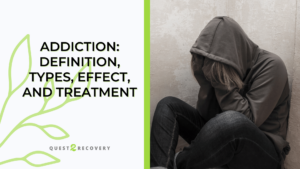Marijuana addiction is a condition where an individual has an intense urge to consume marijuana despite knowing and experiencing its negative consequences. Regular use of marijuana gives the user the feeling of pleasure and euphoria.
The signs of Marijuana addiction include an increased tolerance for the drug, withdrawal symptoms like anxiety and irritability, and changes in appetite.
The causes of marijuana addiction can be biological, environmental, psychological, social, and cultural factors. Common reasons people get addicted to Cannabis include genetics, peer pressure, and social isolation.
The effects of marijuana addiction include mental health problems like depression and anxiety as well as physical health problems like increased heart rate and chronic cough.
Treatments for marijuana addiction include support groups, behavioral therapy, individual counseling, and lifestyle changes. It is vital for people struggling with this addiction to seek professional help.
What Is Marijuana Addiction?
Marijuana addiction is a condition marked by an intense urge to use marijuana despite its adverse effects. Also known as cannabis use disorder, it is similar to other substance use disorders in terms of its development, characteristics, and consequences.
A Marijuana addict is unable to control the urge or consumption, even while the effects are manifesting. Some users experience mild symptoms of the abuse, while others may struggle with severe addiction.
As reported in the 2021 National Survey on Drug Use and Health, approximately 16.3 million people) had a Marijuana addiction in the last 12 months.
What Causes Marijuana Addiction?
The causes of marijuana addiction involve a combination of different factors. The following are the factors that cause or contribute to the development of marijuana addiction:
Biological Factors
Some people are more prone to getting addicted to marijuana due to their genetic predispositions. According to Bevilacqua and Goldman’s 2009 study on Genes and Addictions, genetics play a moderate to significant role in the likelihood of developing addictions. This means that people with a family history of addiction have an increased chance of developing marijuana addiction themselves.
Brain chemistry and structure also play a role in influencing an individual’s response to marijuana and increasing their likelihood of getting addicted to it.
Environmental Factors
Living in an area where marijuana is readily available or legalized increases the chances of use.
Psychological Factors
Mental health problems, such as depression, anxiety, and trauma-related disorders, can increase the chances of getting addicted to marijuana. This happens when individuals with these health issues rely on marijuana as a form of self-medication, which can lead to dependence and addiction.
Also, using marijuana as a drug for coping with stress and anxiety puts one at risk of addiction.
Social And Cultural Factors
Some cultures generally accept the use of marijuana, and this increases the chances of getting addicted. Peer pressure also contributes to environmental factors. According to Egan, Kathleen L. et al’s 2016 study ‘More than just alcohol: Marijuana and illicit drug use at parties attended by 15–20 year olds,’ Marijuana and or other illegal drugs are served in one-third of parties attended by those aged 15 to 20.
Personality Traits
Individuals with personality traits such as impulsivity, sensation-seeking behavior, and adrenaline-seeking have a high chance of developing an addiction to marijuana.
What Are The Effects Of Marijuana Addiction?
The effects of marijuana addiction cut across all aspects of an addicted individual’s life, including their finances and relationships.
The following are some of the effects Marijuana addiction has on the user:
Physical Health Effects:
- Marijuana smoking increases the chances of respiratory problems. The effects of inhaling marijuana smoke are similar to those of tobacco, including chronic bronchitis and other respiratory infections.
- Marijuana has been linked to an increase in cardiovascular issues such as arrhythmia, high blood pressure, and arrhythmia.
- Marijuana causes impaired coordination, balance, and reaction time. These effects increase the risk of accidents and injuries.
Mental Health Effects
- Long-term use of marijuana increases the risk of cognitive deficits in memory, learning, and attention abilities.
- Marijuana addiction is associated with an increased risk of mental health disorders such as psychosis, schizophrenia, depression, and anxiety.
- Chronic marijuana usage increases an individual’s motivation, ambition, and goal-directional behavior. This effect affects individuals’ academic and occupational performance.
Social Effects
- Marijuana increases the risk of interpersonal strain. When an individual prioritizes marijuana over other responsibilities, they will experience strain in their relationships with family, friends, work, and loved ones.
- It causes social withdrawal. Cannabis addicts find themselves withdrawing from social activities, friends, and family.
Legal And Financial Effects
- Marijuana is illegal in most states and countries. Possession, distribution, or cultivation of marijuana has legal consequences.
- It also puts a strain on the user’s finances because the cost of buying the drug can add up to a huge amount over time.
- It can also have a negative impact on academic performance and attendance.
- Maintaining employment is very difficult with marijuana addiction.
What Are The Signs Of Marijuana Addiction?
Signs of Marijuana addiction can be psychological, physical, or social. The following are the common symptoms exhibited by people addicted to marijuana:
- Increased tolerance: Excessive use of marijuana increases the amount necessary to achieve the desired “rewarding” effect.
- Withdrawal symptoms: When the user tries to discontinue, signs like irritability, restlessness, insomnia, decreased appetite, and mood swings occur.
- Compulsive use: Increased usage of marijuana reduces the user’s ability to control or reduce the use of marijuana, even if they try or want to.
- Preoccupation with Marijuana: Marijuana addicts spend time looking for, obtaining, and using the drug. They constantly think of when and how they can get and use next.
- Persistent usage: People addicted to marijuana do not have control and continue to use the substance even when it has negative consequences.
- Social withdrawal: Marijuana addiction increases social withdrawal. Individuals with Cannabis use disorder prefer to spend time alone or with only marijuana users.
- Change in behavior: Prolonged use of marijuana increases irritability, anxiety, and depression.
Signs of marijuana addiction tend to differ with individuals, but these are the most common signs.
How Does Long-term Marijuana Addiction Affect Physical Health?
Long-term marijuana addiction affects physical health, though it may not be as severe as that of substances like tobacco or alcohol. Heavy marijuana use increases the risk of the following health factors:
- Respiratory problems: Marijuana intake affects the human respiratory system. Chronic marijuana smokers experience wheezing, coughing, bronchitis, and a huge increase in respiratory infections.
- Lung damage: Long-term marijuana use has been associated with a high chance of cardiovascular issues like heart attack, elevated heart rate, high blood pressure, and stroke.
- Impaired immune function: Research suggests that chronic marijuana usage increases the risk of immune system suppression. It makes individuals more likely to contract infections and illnesses.
- Hormonal effects: Marijuana addiction leads to decreased testosterone levels and sperm count in men and affects menstrual cycles and fertility in women.
- Cognitive impairment: Long-term use of marijuana impairs cognitive function, including memory function, attention, and learning abilities. Marijuana addiction impacts the user’s overall ability to function properly.
- Risk of cancer: Smoked Marijuana introduces toxins and carcinogens to the lungs. Further studies are required to understand the potential impact of marijuana on lung and other types of respiratory cancers.
- Adverse effects on pregnancy: According to a 2023 research by the University of Utah Health, there is a link between cannabis use during pregnancy and a variety of adverse pregnancy outcomes, particularly low birth weight. The scientists also found that increased exposure to Cannabis heightens the risk of serious complications, including stillbirth, medically induced preterm birth, and disorders related to blood pressure.
How Long Does Marijuana Stay In Your System?
How much time marijuana stays in the human system varies depending on several testing factors, but generally, it can stay in the body for an hour to 30 days.
Occasional Marijuana usage can be detected in urine for up to 1–3 days after use. Regular marijuana users have an increased detection timeline, sometimes up to 1–7 days after use, while chronic users may have marijuana in their urine for up to several weeks after usage.
Tetrahydrocannabinol, THC is detectable in blood for 1-2 days after use, up to 24-72 hours after in saliva, and 2–90 days in hair follicles.
These timelines are general estimates and can differ based on individual factors like metabolism, hydration levels, body fat, and the Marijuana strain or potency.
How Does Marijuana Addiction Affect The Brain?
Marijuana addiction affects the brain in different ways, especially with long-term, chronic use. Here are some of the ways in which marijuana addiction affects the brain:
- Reward system: Marijuana increases the release of dopamine, which is a neurotransmitter associated with pleasure and reward. It reduces the brain’s response to natural rewards and increases the desire for marijuana.
- Brain function: Marijuana addiction alters the brain structure and function, especially those that control learning, attention, and decision-making. The brain’s memory hippocampus, the prefrontal cortex, and the part for emotional and stress responses are the areas most affected.
- Impaired cognitive function: Marijuana addiction increases the risk to the brain’s cognitive function. Its use in adolescence impairs memory, attention, and executive function.
- Mental Disorder: Marijuana addiction also increases the risk of mental disorders and has been associated with psychiatric conditions like depression, anxiety, psychosis, and schizophrenia.
- Brain development: Addiction to Marijuana in adolescence disrupts brain development and can have a long-lasting effect on brain function if not discontinued and treated early enough.
Other effects of marijuana addiction on the brain include withdrawal symptoms such as:
- Neuroplasticity
- Depression
- Anxiety
- Insomnia
- Decreased appetite
What Are The Risk Factors For Marijuana Addiction?
The biggest risk factor for marijuana addiction is age. Individuals below the age of 18 are seven times more likely to be at risk of marijuana disorder. Men are also at higher risk of experiencing marijuana addiction than women.
Other risk factors include:
- Peer pressure
- Sexual abuse
- Family history
- Use of cigarettes
Why is Marijuana Addictive?
Marijuana is addictive because of how it interacts with the brain’s endocannabinoid system. The key psychoactive component in Marijuana, THC, binds to cannabinoid receptors in the brain and triggers the release of dopamine, a neurotransmitter associated with pleasure and the reward system.
The surge in dopamine is what contributes to the euphoria or the ‘high’ associated with marijuana use. Over time, the brain begins to expect these dopamine spikes as normal, leading to a desire to continue using marijuana to replicate the experience.
As marijuana is used more frequently, the brain adapts to its presence. This adaptation manifests as tolerance, where more of the substance is required to achieve the same effect once obtained with smaller amounts. This need for increasing quantities can escalate use, nudging the user towards addictive patterns.
Psychological dependence plays a significant role as well. Many individuals turn to marijuana as a coping mechanism for stress, anxiety, or depression. This reliance on marijuana for emotional regulation can make cessation difficult, as users will feel unable to manage these issues without the drug.
When use is reduced or stopped, withdrawal symptoms can occur, which include irritability, sleep disturbances, appetite changes, restlessness, and physical discomfort. These symptoms can make quitting challenging, as the immediate relief offered by returning to use can seem more appealing than enduring discomfort.
Finally, genetic predisposition also plays a role in the development of Marijuana addiction. Just as with other types of substance use disorders, genetics has been proven to influence an individual’s susceptibility to addiction, making some more prone to developing a dependence on marijuana.
Treatment Options For Marijuana Addiction
Treatment for Marijuana addiction includes a combination of behavioral therapies like support groups, medication, and lifestyle changes.
- Behavioral therapy
Behavioral therapy provides individuals struggling with Marijuana addiction training in stress management, coping mechanisms, and techniques to handle triggers and cravings.
- Motivational enhancement therapy
MET is a counseling approach that helps Marijuana addicts by helping them resolve their mixed feelings about marijuana use and the impact it has on their lives, thereby preparing them for change. Its approach focuses on personal values, concerns, and goals related to marijuana use.
- Support groups
Support groups help persons with Cannabis use disorder get peer support and encouragement to recover from their addiction.
- Group therapy
Group therapy allows individuals to connect with others facing similar challenges.
- Lifestyle changes
Engaging in healthy activities like exercise, hobbies, and hanging out with supportive people can help marijuana addicts deal with their addiction. Addressing stress, such as relationship or financial problems, makes the treatment process more effective.
- Family therapy
Involving family in the therapy process has been shown to foster a supportive recovery environment. It also improves communication and repairs damages that addiction to marijuana may have caused.
- Aftercare
Aftercare programs help individuals remain on track and maintain their recovery from marijuana addiction.
Treatment for marijuana addiction varies depending on the severity of the addiction, the symptoms of the disorder, and the individual goal.
Can marijuana addiction co-occur with other substance use disorders?
Yes, individuals with marijuana addiction may also experience co-occurring substance use disorders involving alcohol, tobacco, or other drugs. Co-use of multiple substances can exacerbate addiction symptoms, complicate treatment outcomes, and increase the risk of adverse health effects.
What are the potential long-term effects of chronic marijuana use?
Chronic marijuana use can lead to various long-term effects on physical health, cognitive functioning, and mental well-being. These may include respiratory issues such as bronchitis and lung infections, cognitive impairments in memory, attention, and decision-making, mental health disorders such as anxiety and depression, and adverse impacts on social and occupational functioning.
Can treatment strategies for marijuana addiction be applied cocaine addiction?
While each substance may present unique challenges and considerations, many treatment modalities, such as cognitive-behavioral therapy, support groups, and pharmacological interventions, which are used for marijuana addiction can be adapted and tailored to help someone with cocaine addiction.
How do the withdrawal symptoms of marijuana addiction compare to those of Percocet addiction?
Examining the withdrawal experiences associated with marijuana addiction and percocet addiction can illuminate the diverse range of physical and psychological challenges individuals may encounter during detoxification and early recovery. While withdrawal symptoms may vary depending on the substance of abuse, common themes such as cravings, mood disturbances, and physical discomforts may be observed across different types of addiction.









